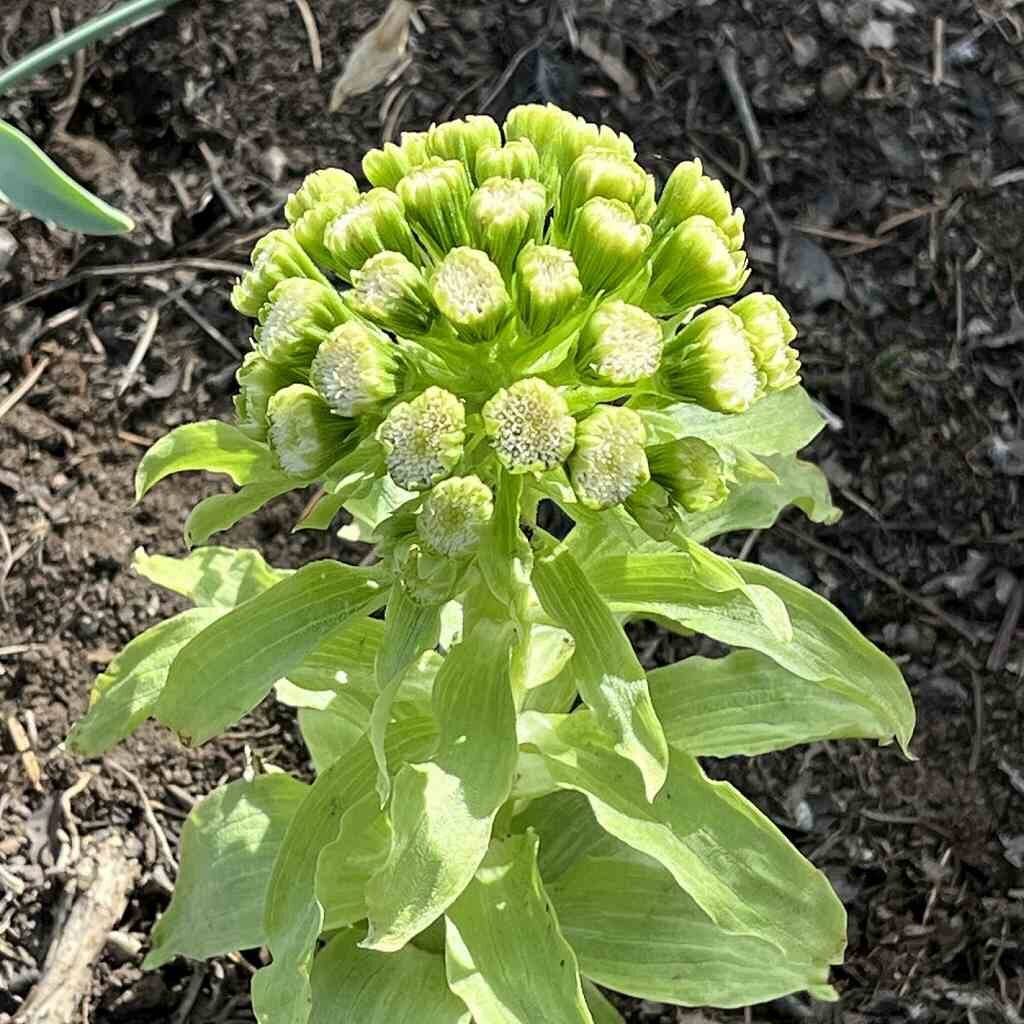フキは早春、苞葉に覆われた花茎を地上に出します。花言葉は「待望」「愛嬌」「仲間」など。野山に自生する一方、改良種が栽培されます。
In early spring, Japanese Butterbur puts flower stalks covered with bracts above the ground. The language of flowers is “long-awaited”, “charming”, “friends”, etc. They grow in nature, and improved varieties are cultivated.
【仮名】フキ, フキノトウ
【和名】蕗, 蕗の薹
【英名】Japanese Butterbur, Fuki
【学名】Petasites japonicus
【誕生】02/ 25, 11/ 17
【開花】02, 03, 04月
【花色】White, Green, Yellow



フキ
フキの生態
フキはキク科の多年草です。日本では北海道から本州、四国、九州まで、国外では樺太から朝鮮半島、中国まで分布。あまり陽がささず、強い風が吹かない、やや湿ったところを好みます。見分けにくいものの、雌雄異株。花言葉は花茎の様子から「待望」「愛嬌」「仲間」などです。
フキの名前
フキの名前の由来はまだ寒い時期に黄色の花が咲くから「冬黄」、大きな葉で汚れをぬぐったから「拭き」など。英名バターバーは昔、この葉でバターを包んで保存したからです。ラテン語の属名ペタシテスは「雨よけ用の大きな帽子」、種小名ジャポニクスは「日本の」という意味。
フキの姿形
フキは早春、苞葉に覆われた花茎を地上に出します。花は雄株が黄色の両性花、雌株が白色の雌性花。雌株は花後に痩果を結びます。葉は太い葉柄を長く伸ばし、丸い葉身を大きく広げますが、夏の暑さで生育が停滞。秋に盛り返すものの寒くなると萎れ、冬は地下茎だけになります。
フキの種類
フキは灰汁の強い「山蕗」が野山に自生する一方、灰汁の少ない改良種が各地で栽培されます。寒冷地の「秋田蕗」は大型で葉柄が固く、佃煮や砂糖漬けなどに加工。中部地方の「尾張蕗」は葉柄が太く、根元が赤色です。関西の「水蕗」は流通が少ないものの、小型で葉柄が柔らか。
フキの利用
フキは早春の柔らかい花茎「蕗の薹」を天ぷらなどに。有効成分セスキテルペンを含み、昔から生薬として食欲増進や痰切りにも用いられました。また、花後の葉柄「蕗」を醤油と酒、砂糖で煮詰めて伽羅蕗などに。ただし、毒性のあるペタシテニンを含むため、灰汁抜きが必要です。
Japanese Butterbur
Japanese Butterbur is a perennial plant of the Asteraceae family. In Japan, it is distributed from Hokkaido to Honshu, Shikoku, and Kyushu, and overseas from Karafuto to the Korean Peninsula and China. Prefers a slightly damp location without too much sun and strong winds. Dioecious, although difficult to distinguish. From the appearance of the flower stalk, the flower language is “long-awaited”, “charming”, “friends”, etc.
Japanese Butterbur is called “Fuki” in Japan. Fuki originally means that the yellow flowers bloom in the cold season, or the large leaves wipe away dirt. The English name Butterbur is because in the past, butter was wrapped in this leaf and preserved. The Latin genus name Petasites means “large hat for protection from the rain”, and the specific epithet japonicus means “Japan”.
In early spring, Japanese Butterbur puts flower stalks covered with bracts above the ground. Male plants produce yellow bisexual flowers and female plants produce white female flowers. The female plant bears an achene after flowering. The leaves have long thick petioles and wide round leaf blades, but their growth is stagnant in the heat of summer. Although it revives in autumn, it wilts when it gets cold, and only underground stems remain in winter.
“Yama-fuki” with strong lye grows naturally in the mountains, and improved varieties with less lye are cultivated in various places. “Akita-fuki” grown in cold regions is large and has hard petioles, and is processed into tsukudani (food boiled in soy sauce) and pickled in sugar. “Owari-fuki” in the Chubu region has thick petioles and red roots. Kansai “Mizu-fuki” is not widely distributed, but it is small and has soft petioles.
Soft flower stalks of Japanese Butterbur in early spring has long been used in tempura. It contains the active ingredient Sesquiterpene, and has long been used as a herbal medicine to increase appetite and clear phlegm. In addition, the leaf stalk after the flower is boiled down with soy sauce, sake, and sugar to make “Kyarabuki”. However, it must be removed lye as it contains toxic Petasitenine.


